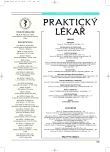-
Články
Top novinky
Reklama- Vzdělávání
- Časopisy
Top články
Nové číslo
- Témata
Top novinky
Reklama- Kongresy
- Videa
- Podcasty
Nové podcasty
Reklama- Kariéra
Doporučené pozice
Reklama- Praxe
Top novinky
ReklamaKortikosteroidy nejsou indikovány k prevenci vzniku stenóz po požití žíravin
Prevention of stenoses following ingestion of caustic substances is not an indication for corticosteroids.
Afrequent complication on ingestion of acids or lye is the formation of esophageal strictures. There are conflicting views on the administration of corticosteroids for their prevention. Therefore the aim of the present
study was to compare present-day data in the literature and to assess corticosteroid therapy. Articles dealing with corrosive injury to the esophagus over the years 1991 – 2003 were researched on Medline and Scirus. The criterion for inclusion in the study was an endoscopically documented 2nd or 3rd degree of esophageal injury and at least 8-day therapy with corticosteroids or without corticosteroids. The data have been evaluated by the Pearson chi-square test at the 0.01 level of significance. There have been found six studies including 211 patients, of which four studies included the application of corticosteroids and two treated the patients without corticosteroids. Esophageal stenosis in 2nd degree injury was found in 15.4% of cases under corticosteroid therapy and in 6.3% of cases treated without corticosteroids, the difference not being statistically significant. In studies dealing with 3rd degree injury the incidence of strictures was significantly higher, namely 92.3%, in studies without corticosteroid therapy was only 23.1%.
A summary of the results of three overview studies in the years 1990 – 2004 including 505 patients only confirmed the following conclusion:
The analysis of studies has not demonstrated any favorable effect of corticosteroid therapy in 2nd and 3rd degree corrosive lesions of the esophagus. In 3rd degree injuries the results were even worse significantly. Corticosteroid therapy is not indicated in corrosive esophageal injury; even the worsening of healing and an increase in the number of esophageal strictures cannot be ruled out.Key words:
corrosives – corticosteroids – esophagus – strictures
Autoři: D. Pelclová 1; T. Navrátil 1,2
Působiště autorů: Toxikologické informační středisko, Klinika nemocí z povolání 1. LF UK a VFN Praha, přednosta prof. MUDr. Daniela Pelclová, CSc. 2Fyzikální ústav J. Heyrovského, ČSAV Praha 1
Vyšlo v časopise: Prakt. Lék. 2006; 86(3): 130-132
Kategorie: Postgraduální vzdělávání
Souhrn
Častou komplikací po požití kyselin nebo louhuje tvorba striktur jícnu. Na podávání kortikosteroidů k jejich prevenci jsou kontroverzní názory, proto bylo cílem této studie porovnat současné údaje z literatury a zhodnotit efekt léčby kortikosteroidy. V databázích Medline a Scirus byly vyhledány články, týkající se korozívního poškození jícnu v letech 1991-2003. Kritériem pro zahrnutí do studie byl endoskopicky dokumentovaný 2. nebo 3. stupeň poškození jícnu a alespoň 8denní terapie pacienta kortikosteroidy nebo terapie bez kortikosteroidů. Data byla zhodnocena Pearsonovým testem chí kvadrát na hladině významnosti 0,01.
Bylo nalezeno šest studií s celkem 211 pacienty, z toho čtyři studie používaly kortikosteroidy, dvě léčily pacienty bez kortikosteroidů. Stenóz jícnu po poškození 2. stupně bylo ve studiích, které používaly v léčbě kortikosteroidy 15,4 %, ve studiích bez kortikosteroidů 6,3 %, rozdíl nebyl statisticky významný. Ve studiích s poškozením 3. stupně byl výskyt stenóz významně častější, a to 92,3 %, ve studiích bez kortikosteroidů jen 23,1 %. Shrnutí výsledků tří přehledových studií, publikovaných v letech 1990 - 2004, a zahrnujících 505 pacientů potvrzuje tento závěr:
Analýza studií neprokázala příznivý efekt terapie kortikosteroidy u korozívních lézí jícnu 2. ani 3. stupně. U poškození jícnu 3. stupni byly výsledky dokonce významně horší. Léčba kortikosteroidy není u postižení jícnu korozivy indikována, nelze při ní dokonce vyloučit zhoršení průběhu hojení a zvýšení počtu striktur jícnu.Klíčová slova:
korozivní látky - kortikosteroidy - jícen - striktury
Štítky
Praktické lékařství pro děti a dorost Praktické lékařství pro dospělé
Článek vyšel v časopisePraktický lékař
Nejčtenější tento týden
2006 Číslo 3- Není statin jako statin aneb praktický přehled rozdílů jednotlivých molekul
- Metamizol jako analgetikum první volby: kdy, pro koho, jak a proč?
- Infekce močových cest u dospělých – mezery v současných guidelines a doporučení pro klinickou praxi
- Isoprinosin je bezpečný a účinný v léčbě pacientů s akutní respirační virovou infekcí
- Horní limit denní dávky vitaminu D: Jaké množství je ještě bezpečné?
-
Všechny články tohoto čísla
- Častí uživatelé zdravotnické péče
- Kortikosteroidy nejsou indikovány k prevenci vzniku stenóz po požití žíravin
- Vrozená syfilis celosvětově znovu na scéně I. Epidemiologie a diagnostika syfilis - zvláště gravidních žen a dětí
- Aktuální situace v užívání návykových látek v ČR a založení nového oboru adiktologie
- Dokonaná sebevražda jako konečný důsledek závislosti na benzodiazepinech
- Heidelberg retina tomograph II (HRT II) v diagnostice glaukomu.
- Responzivnost v praxi: hodnocení zdravotnických služeb v Boskovicích
- Akutní rinosinusitida v ordinaci praktického lékaře
- Úroveň vzdělání a vystupování posluchačů u zkoušky z lékařské mikrobiologie
- Psychologické determinanty používání kondomů
- Prohlídka místa činu při střelném poranění - postup lékaře
- Praktický lékař
- Archiv čísel
- Aktuální číslo
- Informace o časopisu
Nejčtenější v tomto čísle- Dokonaná sebevražda jako konečný důsledek závislosti na benzodiazepinech
- Akutní rinosinusitida v ordinaci praktického lékaře
- Heidelberg retina tomograph II (HRT II) v diagnostice glaukomu.
- Vrozená syfilis celosvětově znovu na scéně I. Epidemiologie a diagnostika syfilis - zvláště gravidních žen a dětí
Kurzy
Zvyšte si kvalifikaci online z pohodlí domova
Autoři: prof. MUDr. Vladimír Palička, CSc., Dr.h.c., doc. MUDr. Václav Vyskočil, Ph.D., MUDr. Petr Kasalický, CSc., MUDr. Jan Rosa, Ing. Pavel Havlík, Ing. Jan Adam, Hana Hejnová, DiS., Jana Křenková
Autoři: MUDr. Irena Krčmová, CSc.
Autoři: MDDr. Eleonóra Ivančová, PhD., MHA
Autoři: prof. MUDr. Eva Kubala Havrdová, DrSc.
Všechny kurzyPřihlášení#ADS_BOTTOM_SCRIPTS#Zapomenuté hesloZadejte e-mailovou adresu, se kterou jste vytvářel(a) účet, budou Vám na ni zaslány informace k nastavení nového hesla.
- Vzdělávání



